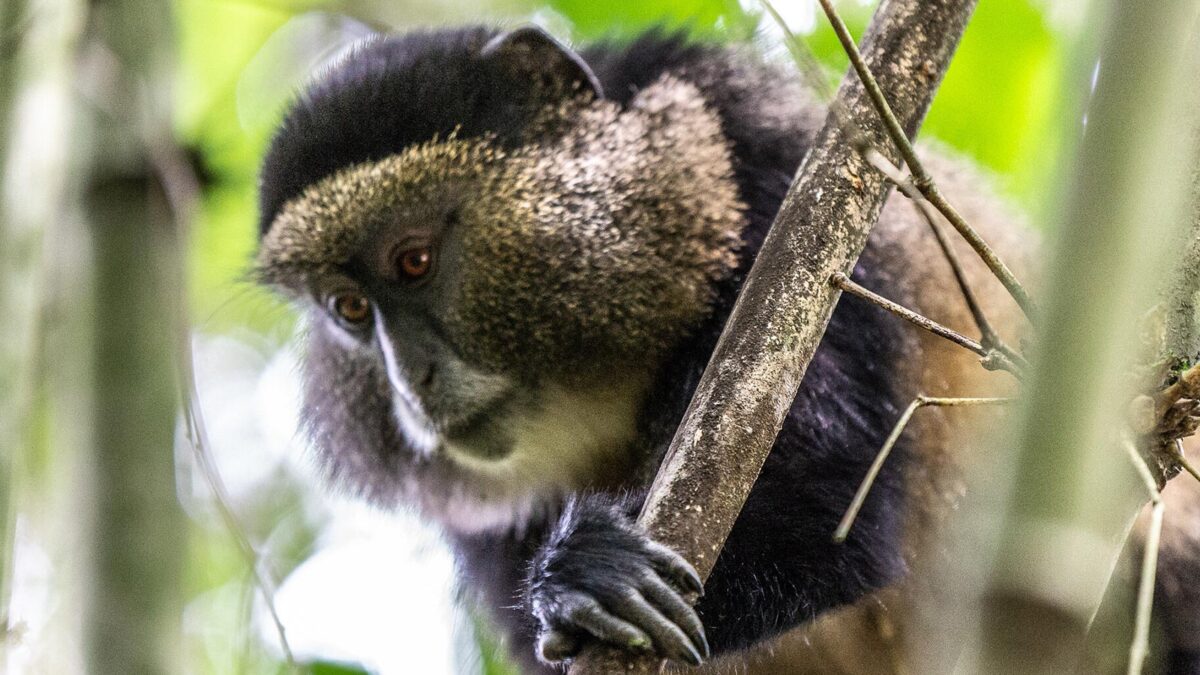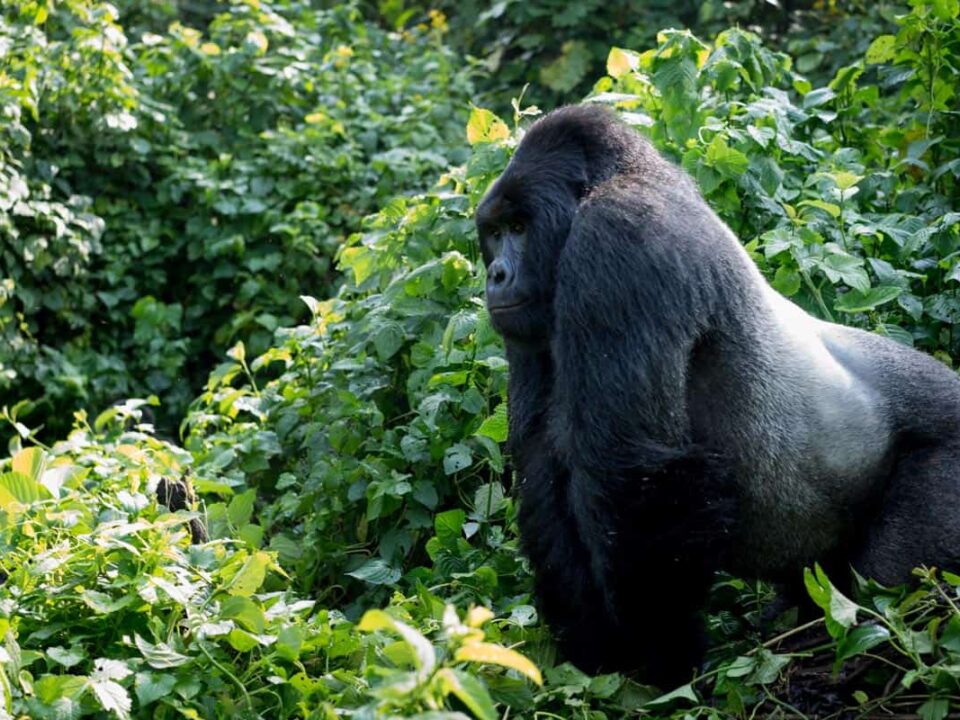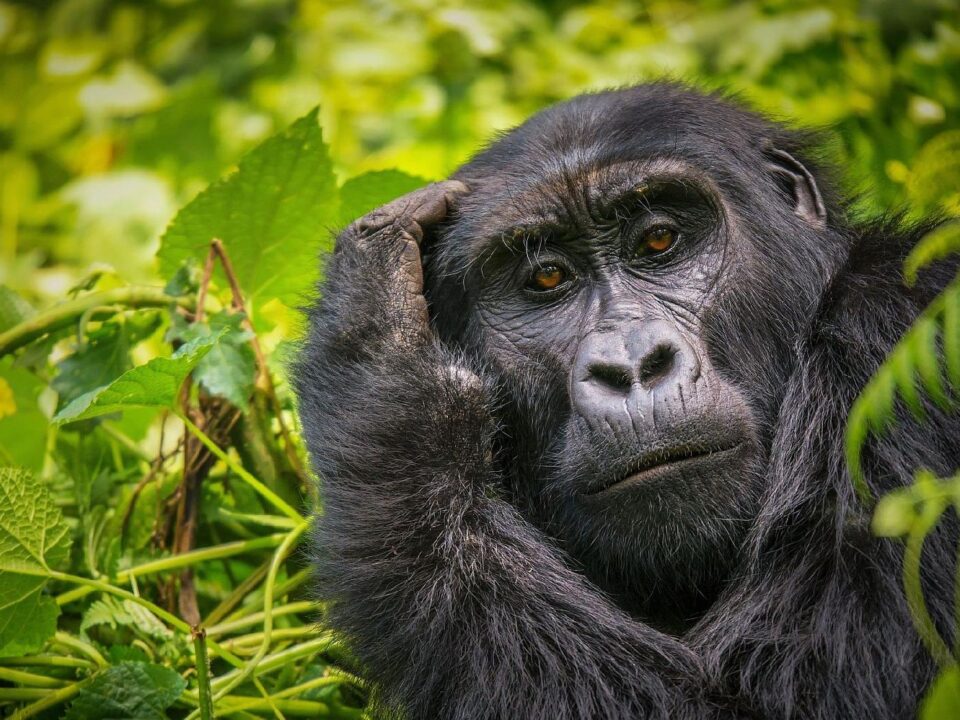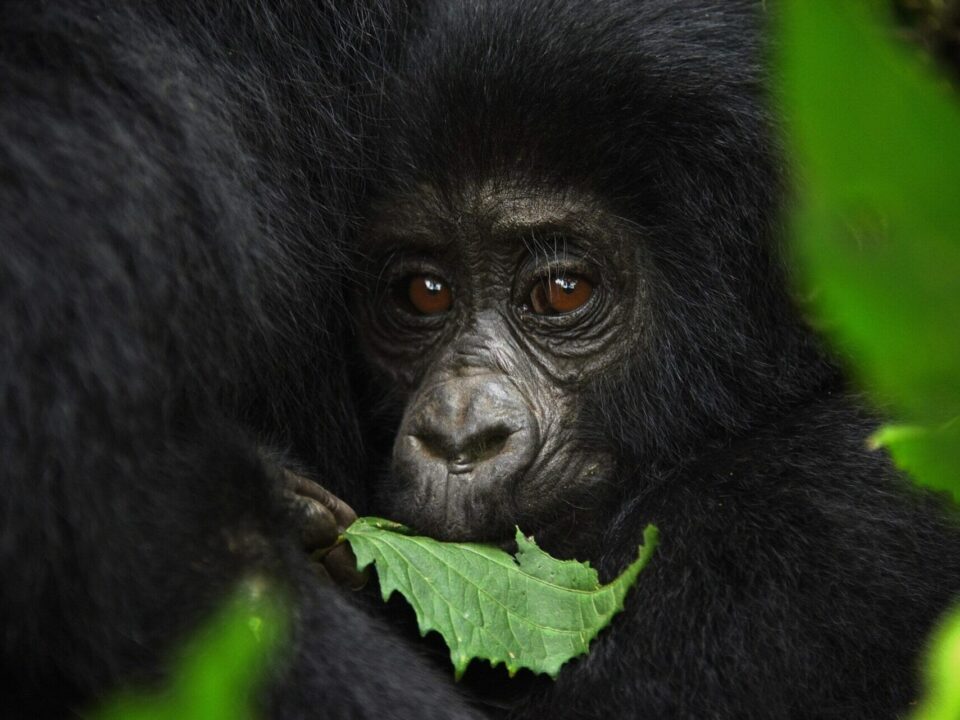Primates in Uganda

A Comparison of Rwanda Gorilla Trekking and Bwindi Gorilla Habituation Experience
January 23, 2023How Many Hours Can One Spend with Chimpanzees in Kibale Forest National Park?
January 25, 2023Uganda is a prime destination for those interested in primates, as it boasts the highest concentration of primate species in Africa. Both habituated and non-habituated primate species can be found in this country, with a total of 20 different primate species present. One of the best places to see a variety of primate species is Kibale Forest National Park, where 13 different primate species can be found. These include chimpanzees, black and white colobus monkeys, red-tailed monkeys, grey-cheeked mangabey, dwarf galago, blue monkeys, L’hoest monkeys, vervet monkeys, olive baboons, patas monkeys, bush babies, and pottos. Among these diverse species, the most famous primates in Uganda are the endangered mountain gorillas, chimpanzees, and the unique golden monkeys. These three species are particularly sought after by visitors to the country and are considered to be some of the most spectacular primates on the continent.
Top Places for Primate Viewing in Uganda
Bwindi Impenetrable National Park
Bwindi Impenetrable National Park is a premier primate viewing destination in Uganda, renowned for its population of endangered mountain gorillas. Visitors to the park have the opportunity to participate in gorilla trekking, an unforgettable experience that allows them to witness these magnificent animals in their natural habitat.
The trekking experience typically begins early in the morning with a briefing on the rules and regulations that must be followed. The duration of the trek can vary, depending on the location of the gorillas on that particular day. It can take anywhere from 30 minutes to 7 hours to reach the gorillas, as they are constantly on the move in search of food.
During the trek, visitors will also have the opportunity to see other primate species, as well as a diverse array of bird species. Once the gorillas are found, visitors will be allowed to spend one hour with them, observing their behavior, habits, and daily activities. This is an unparalleled opportunity to learn about these magnificent animals, take photographs and videos, and create memories that will last a lifetime.
It is important to note that Bwindi Impenetrable National Park is home to half of the world’s mountain gorilla population, making it a must-see destination for any nature lover or wildlife enthusiast. The park is located in the southwest of Uganda and it is a UNESCO World Heritage Site.
Bwindi Impenetrable National Park offers a unique and adventurous activity known as the gorilla habituation experience. This activity allows visitors to participate in the training of wild mountain gorillas to become accustomed to human presence, making them suitable for trekking.
The gorilla habituation experience is a full-day activity, during which visitors will have the opportunity to spend four hours with the gorillas in their natural habitat. This extended time allows visitors to learn and monitor the gorillas, participate in the naming process, watch them feed, breastfeed, groom young ones, and take photographs. This is a truly unique and unparalleled opportunity to gain an in-depth understanding of these magnificent animals and their behaviors.
In terms of cost, a gorilla trekking permit in Bwindi Impenetrable National Park and Mgahinga Gorilla National Park costs USD800 per person for foreign non-residents, USD700 per person for foreign residents, and 300,000 UGX per person for East African citizens. Meanwhile, a gorilla habituation permit costs 1,500 USD per person for foreign non-residents, 1,000 USD per person for foreign residents, and 750,000 UGX per person for East African citizens.
It is important to note that the park is located in the southwest of Uganda and it is a UNESCO World Heritage Site. Gorilla habituation is a rare and exclusive experience that is limited to only 4 groups per day, with a maximum of 8 people per group. It’s an opportunity to have a very personal and intimate experience with the gorillas, in contrast to the traditional gorilla trekking which is limited to an hour and can have more than 8 people per group.
Mgahinga Gorilla National Park
Mgahinga Gorilla National Park is another premier primate viewing destination in Uganda, known for its population of mountain gorillas. Visitors to the park have the opportunity to participate in gorilla trekking, an unforgettable experience that allows them to witness these magnificent animals in their natural habitat.
The park is home to one habituated gorilla family, which is available for trekking on a daily basis. Like Bwindi Impenetrable National Park, the trekking experience typically begins early in the morning with a briefing on the rules and regulations that must be followed. The duration of the trek can vary, depending on the location of the gorillas on that particular day.
During the trek, visitors will also have the opportunity to see other wildlife species. Once the gorillas are located, visitors will be allowed to spend one hour with them, observing their behavior, habits, and daily activities. This is an unparalleled opportunity to learn about these magnificent animals, take photographs and videos, and create memories that will last a lifetime.
It is important to note that Mgahinga Gorilla National Park is one of the smallest national parks in Uganda and it is located in the southwestern part of the country. It is also part of the greater Virunga Conservation Area which includes Mgahinga Gorilla National Park in Uganda, Volcanoes National Park in Rwanda and Virunga National Park in DRC, it is home to about one third of the world’s population of the critically endangered mountain gorillas.
Mgahinga Gorilla National Park is also known for its population of unique golden monkeys, which can be viewed during golden monkey trekking. This activity is an interesting and active adventure that starts early in the morning with a briefing about the rules, regulations and expectations at the park headquarters. After the briefing, visitors will embark on a trek through the forest, following trails of leftover bamboo shoots and leaves. The duration of the trek can vary, depending on the location of the golden monkeys on that particular day, it can take anywhere from 30 minutes to 3 hours to reach them.
Once the golden monkeys are located, visitors will be allowed to spend one hour with them in their natural environment. This is a chance to observe the golden monkeys in their natural habitat, learn about their behavior and habits, and take photographs and videos.
Mgahinga Gorilla National Park also offers a unique experience known as the golden monkey habituation experience. This activity allows visitors to spend four hours in the presence of the golden monkeys, an extended time that allows them to gain a deeper understanding of these unique and endangered primates.
In terms of cost, a golden monkey trekking permit costs 60 USD per person for foreign non-residents, 60 USD per person for foreign residents, and 40,000 UGX per person for East African citizens. Meanwhile, a golden monkey habituation permit costs 100 USD per person for foreign non-residents, 100 USD per person for foreign residents, and 100,000 UGX per person for East African citizens.
It is important to note that the park is located in the southwestern part of Uganda, It is also part of the greater Virunga Conservation Area which includes Mgahinga Gorilla National Park in Uganda, Volcanoes National Park in Rwanda and Virunga National Park in DRC, it is home to about one third of the world’s population of the critically endangered mountain gorillas and also the unique golden monkeys which are only found in this region of the world.
Kibale Forest National Park
Kibale Forest National Park is one of the most popular primate viewing destinations in Uganda, known for its diverse population of primates, including 13 different species, with an estimated 1,500 chimpanzees. The park is a popular destination for chimpanzee trekking, an activity that allows visitors to witness these fascinating animals in their natural habitat.
The trekking experience starts early in the morning with a briefing at the Kanyachu Visitors Centre, where visitors are informed about the rules and regulations of the park. After the briefing, visitors will embark on a trek through the forest in search of chimpanzees, accompanied by an experienced park guide. The duration of the trek can vary, depending on the location of the chimpanzees on that particular day, it can take anywhere from 30 minutes to 4 hours to reach them.
During the trek, visitors will also have the opportunity to see other primate species, as well as a diverse array of bird species, plants, and other wildlife. Once the chimpanzees are located, visitors will be allowed to spend one hour with them, observing their behavior, habits, and daily activities.
Kibale Forest National Park also offers an exclusive experience known as the chimpanzee habituation experience. This activity allows visitors to spend four hours in the presence of the chimpanzees that are under the habituation process. This is an unparalleled opportunity to learn about these magnificent animals, take photographs and videos, and create memories that will last a lifetime.
In terms of cost, a chimpanzee trekking permit in Kibale Forest National Park costs 200 USD per person for foreign non-residents, 150 USD per person for foreign residents, and 150,000 UGX per person for East African citizens. Meanwhile, a chimpanzee habituation permit costs 250 USD per person for foreign non-residents, 250 USD per person for foreign residents, and 150,000 UGX per person for East African citizens. It is important to note that Kibale Forest National Park is located in the western part of Uganda and it is one of the most biodiverse areas in East Africa, it’s also known as the primate capital of the world.
In addition to Bwindi Impenetrable National Park, Mgahinga Gorilla National Park, and Kibale Forest National Park, there are several other destinations in Uganda where visitors can view primates. One such destination is Budongo Forest, which is located within Murchison Falls National Park. Here, visitors have the opportunity to view chimpanzees in their natural habitat.
Another destination for primate viewing is Kyambura Gorge, which is located within Queen Elizabeth National Park. This spectacular gorge is home to a variety of primates, including chimpanzees and black-and-white colobus monkeys.
Toro-Semuliki Wildlife Reserve is another destination for primate viewing. This reserve is located in the western part of Uganda and is known for its large population of chimpanzees and other primates.
Kalinzu Forest Reserve, located in the southwestern part of Uganda, is also a destination for primate viewing. This reserve is home to a wide variety of primates such as chimpanzees, black-and-white colobus monkeys, red-tailed monkeys, and others.
All of these destinations are home to unique and endangered primates that are not found anywhere else in the world and it’s a great opportunity to observe them in their natural habitat. It’s important to note that a permit is required to trek the primates and it’s advisable to book in advance as the numbers are limited to protect the primates.
Gorilla trekking, golden monkey trekking, and chimpanzee trekking permits in Uganda can be obtained through two main channels: directly through the Uganda Wildlife Authority (UWA) or through a trusted tour operator. Trek Africa Expeditions is one such tour operator that can assist visitors in obtaining permits for primate trekking in Uganda.
To book a permit through Trek Africa Expeditions, visitors can contact the company with the date, month, and year of the desired trekking experience, as well as the primate destination they wish to visit. After receiving the inquiry, Trek Africa Expeditions will check for permit availability on the desired dates. If permits are available, the company will request a deposit for the permit.
Once the deposit is received, Trek Africa Expeditions will purchase the permits on behalf of the visitor and send a scanned copy of the receipt as confirmation. It’s also important to note that the prices for the permits vary depending on the destination and the type of permit, and that the permits are limited in order to protect the primates.
The Best Time for Primate Viewing in Uganda
Uganda is home to a diverse population of primates, making it a popular destination for primate viewing. While primates can be visited throughout the year, the best time to go is during the dry season, also known as the peak season. The dry season in Uganda typically falls between the months of June, July, August, September, December, January, and February. During this time, there is less rainfall in the primate destinations, making the access roads and trekking trails dry and passable. This makes trekking easier compared to the wet or rainy season, when the trails can be muddy and slippery, making trekking more difficult.
If you’re interested in visiting Uganda to view primates, you can contact Trek Africa Expeditions for more information or visit our website to book an affordable primate package. Our team will be happy to assist you with planning your trip, and help you make the most of your primate viewing experience.




